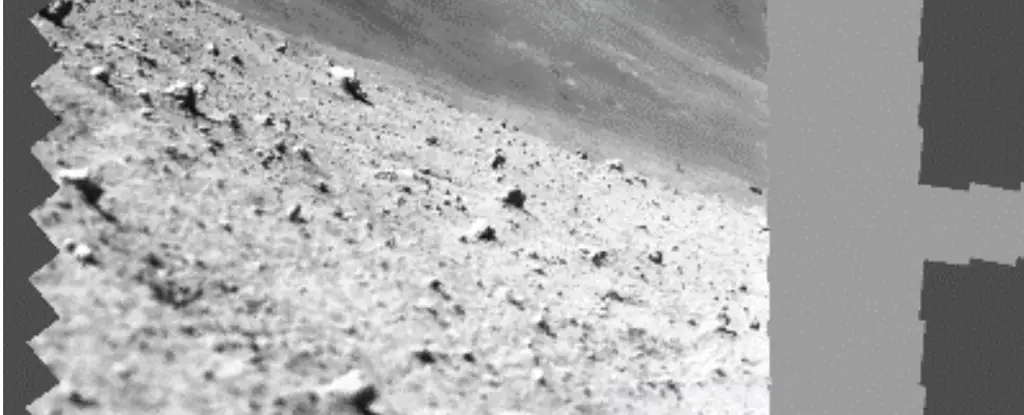Japan’s Moon lander, known as the Smart Lander for Investigating Moon (SLIM), has recently sent back its first images of the lunar surface, providing us with an incredibly detailed view of a gray, rubble-covered world. While the images are undeniably beautiful, they also carry a sense of sadness, as SLIM currently sits upside down on the Moon, unable to continue its operations. This unfortunate turn of events occurred shortly after the Japan Aerospace Exploration Agency (JAXA) was forced to switch off the uncrewed lander, and it remains uncertain whether it will ever be reactivated.
The image captured by SLIM is an amalgamation of 257 monochrome, low-resolution photographs taken by the onboard Multi-Band Camera (MBC). Unfortunately, the image is incomplete, as the camera stopped scanning before obtaining a full view of the lunar surface. Nevertheless, these initial pictures offer a unique perspective on Earth’s celestial neighbor and showcase the potential for future exploration and scientific discoveries.
SLIM, often referred to as the “Moon Sniper,” possessed remarkable precision landing capabilities. However, due to an unforeseen mishap, the craft landed on its nose, causing its solar panels to be obstructed and rendering them unable to generate power. Recognizing the importance of conserving energy, JAXA made the difficult decision to power off the lander approximately three hours after touchdown, in the hopes that SLIM will resume its operations once sunlight illuminates its solar panels.
Despite its truncated lifespan, SLIM managed to capture valuable information during its brief window of activity. JAXA has zoomed in on the images and begun identifying and naming intriguing rocks scattered across the lunar surface. Embracing a lighthearted approach, these rocks have been given charming dog-themed names like SHIBAINU and Toy Poodle. Additionally, the MBC successfully snapped a picture of SLIM itself, firmly lodged in its nose-down position, offering a poignant visual representation of the lander’s current predicament.
Alongside SLIM, two payloads named LEV-1 and LEV-2 were released and are currently traversing the Moon. LEV-2, in particular, is a shape-shifting rover that was partially developed by a toy company famous for creating the iconic Transformers. The successful deployment of these payloads fills the team at JAXA with a sense of pride and accomplishment. Project manager Shinichiro Sakai expressed his amazement at seeing their creation on the Moon, stating, “I almost fell down when I saw it.” This achievement highlights Japan’s ability to navigate the challenging terrain of outer space and opens doors to new possibilities in lunar exploration.
Although SLIM currently remains dormant, there is a glimmer of hope in the project’s future. If sunlight were to once again hit the lander’s solar panels, the mission could be reignited. Scientists eagerly anticipate SLIM resuming its activities and capturing a range of spectroscopic photos that would aid in identifying the chemical composition of the lunar surface. Such information would be invaluable in deepening our understanding of the Moon and its geological history.
While the fate of SLIM hangs precariously in the balance, its brief exploration has nevertheless left an indelible mark on lunar research. JAXA’s Moon lander has showcased Japan’s technological capabilities and demonstrated their capacity to land precisely on the Moon’s surface. This achievement signifies a significant milestone in Japan’s space program, as the country joins an exclusive group of nations, including the United States, Russia, China, and India, that have successfully reached and landed on the Moon.
Japan’s SLIM Moon lander may be currently inactive, but its mission has undoubtedly captured our imagination and awakened our curiosity about Earth’s celestial companion. Through its stunning images, SLIM has provided us with a glimpse of the lunar surface, a terrain both beautiful and desolate. As we await the possibility of SLIM springing back into action, it serves as a symbol of human perseverance in the pursuit of scientific discovery and exploration beyond our home planet.

Leave a Reply